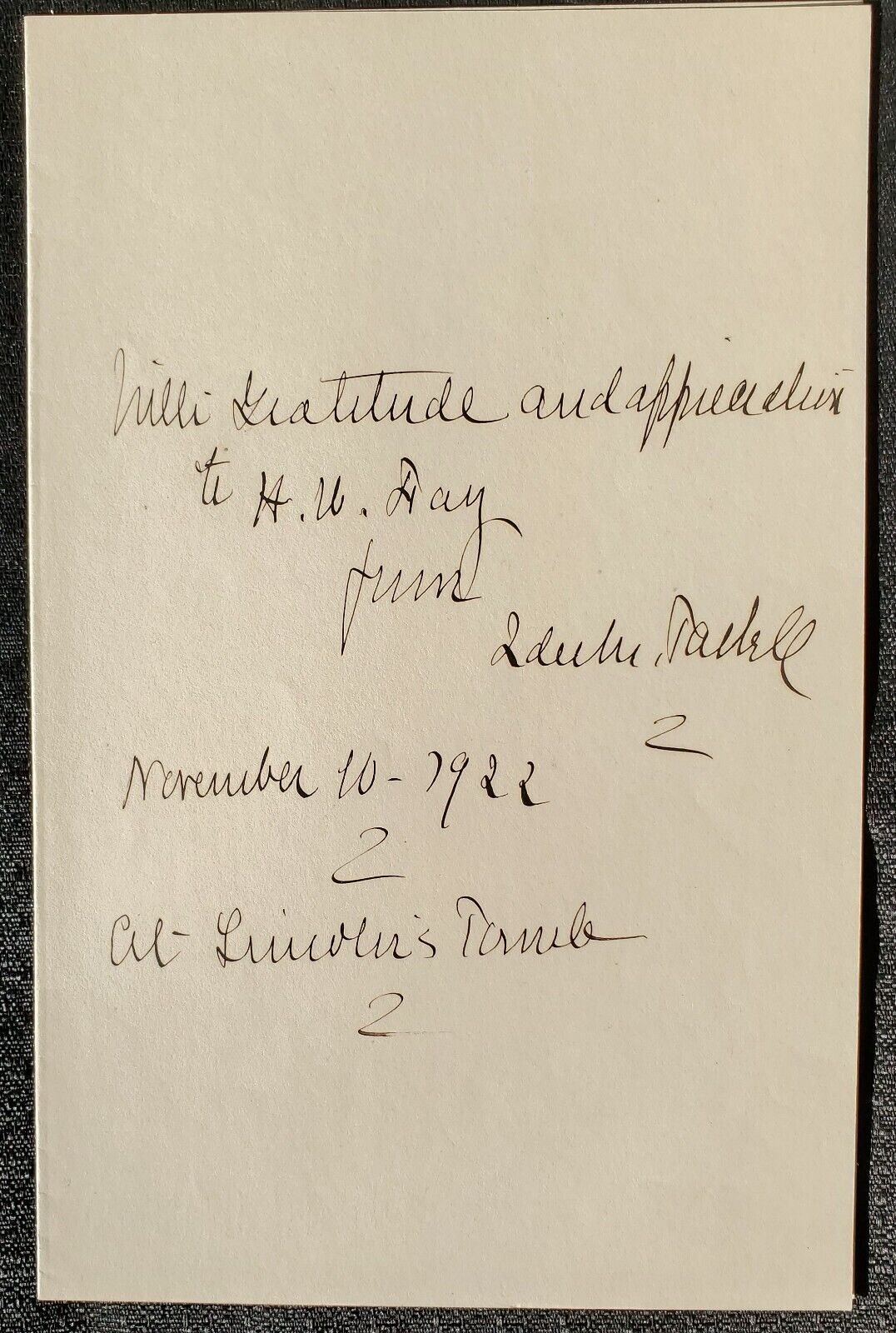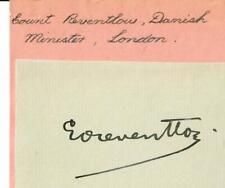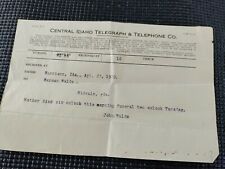1922 Ida M. Tarbell At Abraham Lincoln's Tomb Autograph Letter Writer Journalist For Sale

When you click on links to various merchants on this site and make a purchase, this can result in this site earning a commission. Affiliate programs and affiliations include, but are not limited to, the eBay Partner Network.
1922 Ida M. Tarbell At Abraham Lincoln's Tomb Autograph Letter Writer Journalist:
$199.00
This 1922 Ida M. Tarbell At Abraham Lincoln's Tomb Autograph Letter is the exact item you will receive and has been certified Authentic by REM Fine Collectibles.Ida Minerva Tarbell (November 5, 1857 – January 6, 1944) was an American writer, investigative journalist, biographer and lecturer.
She wrote numerous books and works on Abraham Lincoln, including ones that focused on his early life and career. A prolific writer and lecturer, Tarbell was known for taking complex subjects — such as the oil industry, tariffs, labor practices — and breaking them down into informative and easily understood articles.
Born in Pennsylvania at the beginning of the oil boom, Tarbell is known for her 1904 book The History of the Standard Oil Company. The book was first published as a series of articles in McClure's from 1902 to 1904. It has been called a "masterpiece of investigative journalism", by historian J. North Conway, as well as "the single most influential book on business ever published in the United States" by historian Daniel Yergin.
The work contributed to the dissolution of the Standard Oil monopoly and helped usher in the Hepburn Act of 1906, the Mann-Elkins Act, the creation of the Federal Trade Commission (FTC), and the passage of the Clayton Antitrust Act.
Her articles drove circulation at McClure’s Magazine and The American Magazine and many of her books were popular with the general American public. She was one of the leading muckrakers and reformers of the Progressive Era of the late 19th and early 20th centuries and was a pioneer of investigative journalism.
A McClure's story meant to compete against Century Magazine was on US president Abraham Lincoln, on whom Century had published a series by his private secretaries, John Nicolay and John Hay was given to Tarbell.
At first, Tarbell was reluctant to take up work on Lincoln as she later said, "If you once get into American history, I told myself, you know well enough that will finish France." At the same time, however, Tarbell had been fascinated with Lincoln since she was a young girl.
She remembered the news of his assassination and her parents' reaction to it: her father coming home from his shop, her mother burying her "face in her apron, running into her room sobbing as if her heart would break."
When Tarbell first approached John Nicolay, he told her that he and Hay had written "all that was worth telling of Lincoln". Tarbell decided to begin with Lincoln's origins and his humble beginnings. Tarbell traveled the country meeting with and interviewing people who had known Lincoln—including his son Robert Todd Lincoln.
Robert Lincoln shared with Tarbell an early and previously unpublished daguerreotype of Lincoln as a younger man.
She followed up on a lost 1856 speech by Lincoln by tracking down Henry Clay Whitney—who claimed to have written down notes—and then confirming his notes via other witnesses. Whitney's version of the speech was published in McClure's, but has since been disproved by other historians.
Tarbell's research in the backwoods of Kentucky and Illinois uncovered the true story of Lincoln's childhood and youth. She wrote to and interviewed hundreds of people who knew or had contact with Lincoln.
She tracked down leads and then confirmed their sources. She sent hundreds of letters looking for images of Lincoln and found evidence of more than three hundred previously unpublished Lincoln letters and speeches.
Tarbell met with John H. Finley while visiting Knox College where Lincoln famously debated Stephen Douglas in 1858. Finley was the young college President, and he would go on to contribute to Tarbell's work on Standard Oil and rise to become the editor of The New York Times.
Tarbell traveled abroad to Europe, discovering that a rumor that Lincoln had appealed to Queen Victoria to not recognize the Confederacy was, in fact, false.
By December 1895, the popular series by Tarbell once again helped boost McClure's circulation to over 250,000 which climbed to over 300,000, by 1900, making it higher than its rivals. This occurred even as the editors at Century's Magazine sneered, "They got a girl to write the Life of Lincoln." McClure would go on to use the money generated by Tarbell's articles to buy a printing plant and a bindery.
It was at this time that Tarbell decided to be a writer and not an editor. The articles were collected in a book, giving Tarbell a national reputation as a major writer and the leading authority on the slain president.
Tarbell published five books about Lincoln and traveled on the lecture circuit, recounting her discoveries to large audiences.
Tarbell continued to write profiles for McClure in the late 1890s. While there, she had the opportunity to observe the United States expansion into imperialism through the Spanish–American War.
She was writing a series on military affairs, and in 1898 she was set to interview Nelson A. Miles, the commanding general of the United States, when the battleship the USS Maine was blown up in Havana Harbor. Tarbell was allowed to keep her appointment nonetheless and observe the response at the U.S. Army Headquarters.
After a successful career as both writer and editor for McClure’s Magazine, Tarbell left with several other editors to buy and publish The American Magazine. Tarbell also traveled to all of the then 48 states on the lecture circuit and spoke on subjects including the evils of war, world peace, American politics, trusts, tariffs, labor practices, and women's issues.
Tarbell took part in professional organizations and served on two Presidential committees. She helped form the Authors’ League (now the Author's Guild) and was President of the Pen and Brush Club for 30 years.
During World War I, she served on President Woodrow Wilson's Women's Committee on the Council of National Defense. After the war, Tarbell served on President Warren G. Harding's 1921 Unemployment Conference.Ida Minerva Tarbell (November 5, 1857 – January 6, 1944) was an American writer, investigative journalist, biographer and lecturer.
Tarbell also wrote several biographies over the course of her 64-year career. She wrote biographies on Madame Roland and Napoleon. Tarbell believed that "the Truth and motivations of powerful human beings could be discovered." That Truth, she became convinced, could be conveyed in such a way as "to precipitate meaningful social change."

Related Items:
1922 Ida M. Tarbell At Abraham Lincoln's Tomb Autograph Letter Writer Journalist
$194.00
"Danish Envoy in London" Eduard Reventlow Signed 3.75X2 Card
$299.99
Central Idaho Telegraph & Telephone Co. Harrison Ida. 1922 Mother Died Telegraph
$15.00



